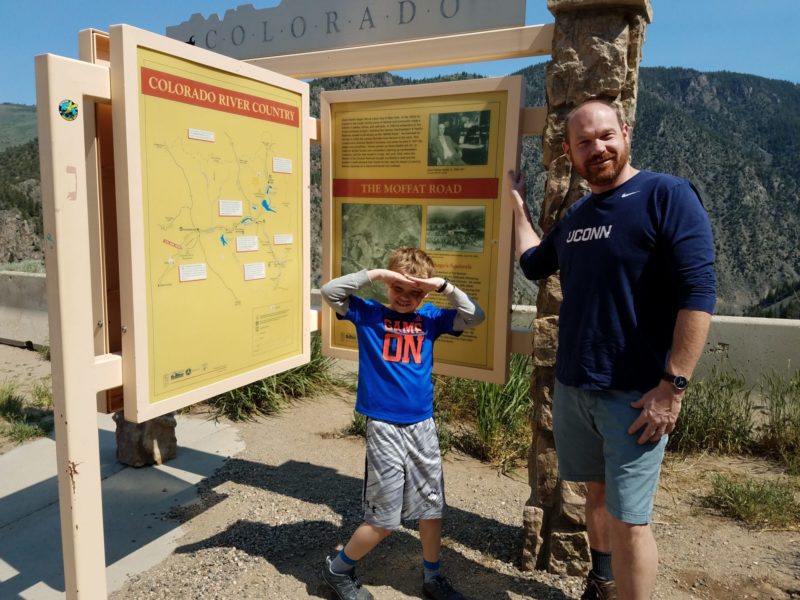How we grow: Driving innovation
09 October 2019 – Tom Scheinfeldt
Editor’s Note: This post is part of a series that illustrates the role of the NCPH Endowment in supporting the work of the organization. To find out more about how the NCPH Endowment Fund supports the work of public historians and to make your gift, please visit: https://ncph.org/giving/endowment/.
In this post, we hear from Tom Scheinfeldt, associate professor of Digital Humanities at the University of Connecticut where he holds a joint appointment in the Department of Digital Media and Design and the Department of History.

Tom stands next to one of the markers he worked on in the 1990s when he first learned about the work of NCPH. Photo credit Tom Scheinfeldt.
Why are you a member of NCPH?
I first became aware of NCPH in the mid-1990s. My first job out of college was as assistant coordinator for the Colorado Historical Society’s Roadside Interpretation Program. We had been awarded a grant, in partnership with the Colorado Department of Transportation (CDOT), to replace each of the state’s old, cast-iron roadside historical markers with a two- or four-panel fiberglass exhibit. My role in the project was to travel with CDOT staff to the far-flung corners of the state to meet with stakeholders in the dozens of communities in which the new markers would be located. We brought draft texts, image selections, color schemes, right-of-way information, and safety plans with us for community comment. Over early morning Rotary breakfasts and evening town meetings, in diners, public libraries, and VFW halls, we met excitement, anger, mistrust, disagreement, curiosity and all the other feelings with which people approach the past. In ranching communities, Native American reservations, struggling Old West mining towns, trendy ski resorts, tidy suburbs, and neglected public housing developments, we together crafted narratives that cowboys, Indians, miners, truckers, hippies, small business owners, ski bums, and community activists—sometimes all together in the same room—maybe couldn’t totally agree upon, but at least could all live with until the next time the markers would be replaced in a generation or two.
Leading these discussions as a 23-year-old East Coast transplant was, to say the least, a trial by fire. It was in the pages of The Public Historian that this young, white, private school and Ivy League-educated man started to learn how to approach, with humility and open ears, a diversity that I had never before encountered. Moreover, in NCPH I found the awareness that I had colleagues across the country grappling with the same challenges and opportunities. NCPH showed me that this exciting, frustrating, humbling work was something of which I could make a career.
How has the NCPH Endowment fund helped you in your work as a public historian?
The Endowment fund allows NCPH to meet new challenges to the profession as they emerge by supporting exploratory committees and organizational innovation. History@Work, for example, emerged from work led by Cathy Stanton a decade ago, but which was supported directly by the main NCPH offices before digital history was a central concern of the membership. I’m proud to have worked with Cathy, the main office, and with what would eventually become the NCPH Digital Media Group to get this website off the ground. Digital public history has since become core to NCPH’s work, but in the years before that would become clear, it was the Endowment that allowed a group of us to take a chance for the future of the organization.
In what way would you like to see NCPH further support public historians?
I give to the Endowment fund to support the ability of NCPH to meet the challenges of the next generation of public historians. Partly, this is by supporting innovative efforts like History@Work and the Digital Media Group. Partly, it is by supporting aspiring public historians, like the one I was 20 years ago in Colorado. Both things involve taking risks. I hope NCPH remains, as it has been for my entire career, an organization that values new people, new perspectives, new methods, and the promise of the future.
~ Tom Scheinfeldt is the associate professor of Digital Humanities at the University of Connecticut where he holds a joint appointment in the Department of Digital Media and Design and the Department of History.



